Background and survey design
Businesses in Japan find themselves at a pivotal inflection point. Economic and social changes are motivating companies to accelerate their business transformations. But navigating change is not easy, and leaders seek information about how change is successfully implemented in Japan.
To support this need, EY with advice from Professor Koide from Sanno University, conducted a study to identify key success factors for transformations. More than 250 companies participated in the study, sharing Japan-specific transformation information for changes of differing scope and size (entire group company, subsidiary, function or division).
The findings reflect that transformations are becoming more complex and key to increasing transformation success and accelerate adoption is to have dedicated change management resources and activities.
Business transformation trends
Transformation objectives are changing
There are many reasons companies are transforming. The most common objectives of transformations launched in the past 5-7 years, according to the study conducted with more than 250 companies in Japan, were core business expansion (65%), followed by business efficiency (59%). The most challenging types of transformations were executing a significant change in business strategy (33%) and cross-functional transformation (27%).
Looking forward, transformation objectives are shifting from core business expansion and business efficiency improvements to significant business strategy changes and cross-functional transformations, both of which tend to be larger and more complex.
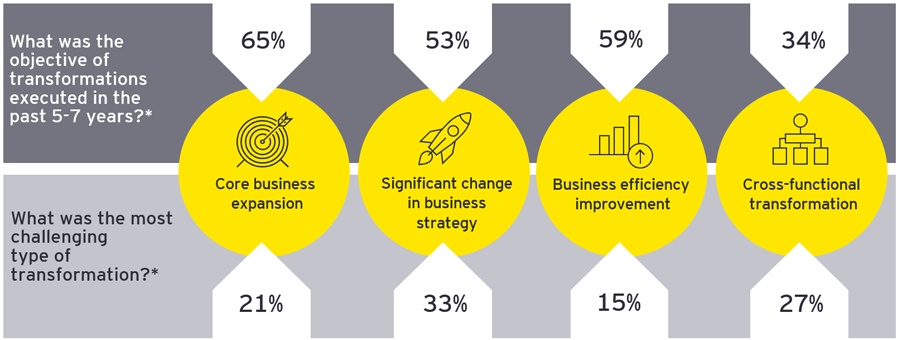
* The figures are the % of companies which chose each transformation type (multiple responses allowed)
Transformation and change success isn’t easy
It is commonly understood that change is difficult and this study confirms it. Only 19% of transformations were completely successful, achieving the project’s objective, timeline and budget. 45% of transformations failed to meet any success criteria.
The more complex the transformation, the lower probability of success. In particular, only 34% of workstyle and mindset change transformations achieved the original objective, whereas 43% of sales and CRM transformations met the objective.

Type of future transformations are changing
Looking forward, companies anticipate developing new businesses and launching cross-functional transformations in the next few years. These types of transformations tend to be larger and more complex.
Considering the success rate of transformations in the past, it is assumed that future transformations will also struggle to achieve success, particularly if they are more complex. Therefore, companies must identify, and plan how to improve the probability of success before launching more difficult transformations.
Learning from other companies, such as the insights identified in this survey, can be vital information for success.

Corporate elements contributing to transformation success
Change management factors
The strength of the corporate capability or culture, before a transformation begins, influences the ability of a business to adapt to the change. Survey participants were asked to choose any of the below organizational elements they felt contributed to the transformation’s success. The most frequently selected answers were the factors related to leadership, which were found to be important especially during the beginning phase of the transformation. Having a clearly articulated corporate vision and strategy is important for the transformation to be linked. Top management and functional leaders need to be aligned with the change vision to gain employee trust. A strong culture of collaboration and cooperation across functions is also an important element.
The survey classified success factors into two categories. Factors that are influenced through change management activities, categorized as “Change management factors”, and factors that are not influenced by change management activities, categorized as “Other factors”. The results show that both types of factors are important to a transformation’s success.
Related article
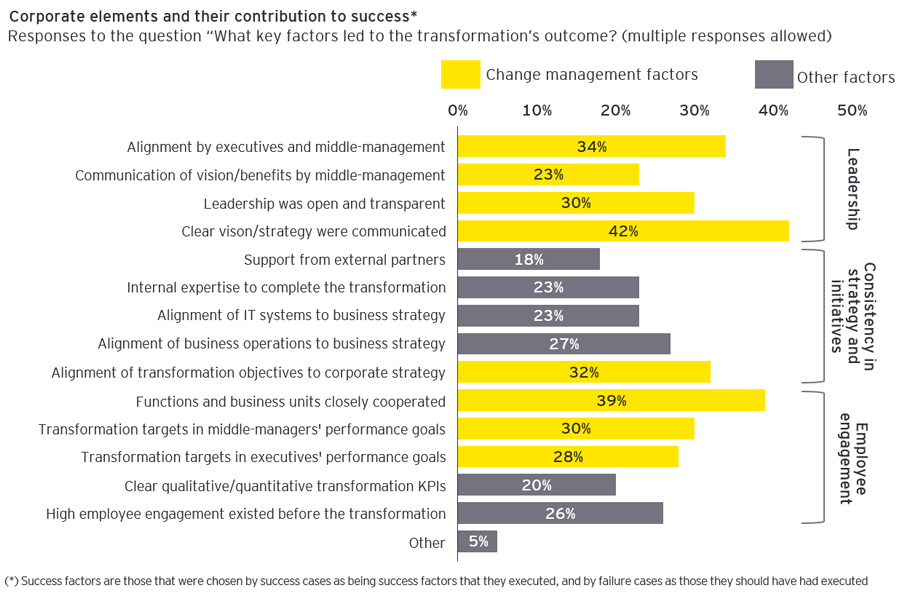
The number of change management factors and success
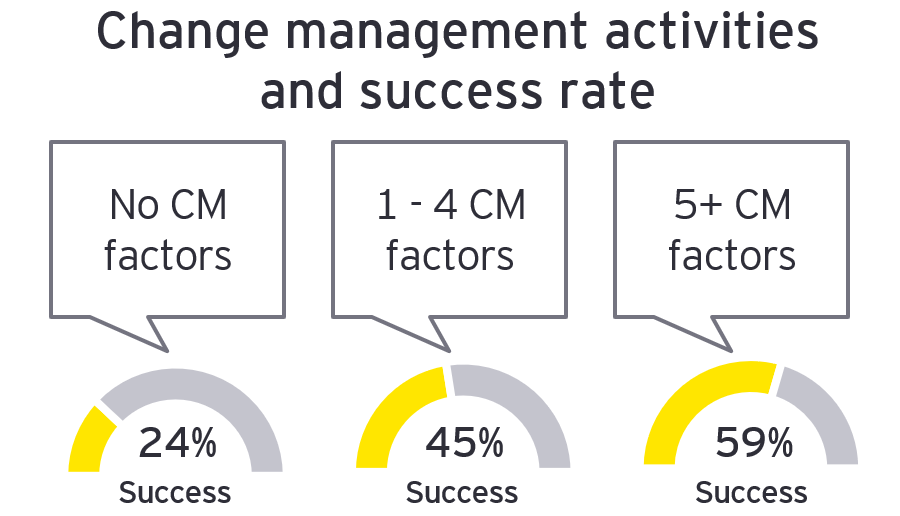
The survey results show that change management is a key success factor for transformations. Our study categorized two types of success factors as explained above – Change management factors and others.
The more change management factors implemented, the higher the transformation success rate.
Change management factors that accelerate change adoption
In addition to the success factors on the previous page, there are specific change adaption activities that contribute to accelerating change adoption that can be executed with any transformation. Below were the top 6 factors considered as key acceleration factors to change.
Top 6 change management factors that accelerate change adoption

Putting people at the center of change leads to greater success
The survey results were clear that transformations with supportive employees leads to success. We asked respondents whether the employees were supportive of the project before, during, and after the transformation. Companies reporting that employees were supportive of the transformation had a higher rate of success. 63% of the success cases responded that employees were supportive of transformation. On the other hand, only 30% of the failure cases had supportive employees.
Importantly, companies that were able to increase employee support as the project progressed, had an even higher likelihood of success. In other words, companies that focused on the people and took actions to increase employee support over the duration of the transformation were more successful.
To increase employee readiness and gain employee support, companies should put people, not process at the center of the change and design a more personalized change experience, rather than managing employees with a standardized change process (see EY Change Experience below). The impact of change management activities to employee support were evident. The data shows that companies that focused on change management efforts were 19 percentage points more likely to have employees supportive of the transformation.
Related article
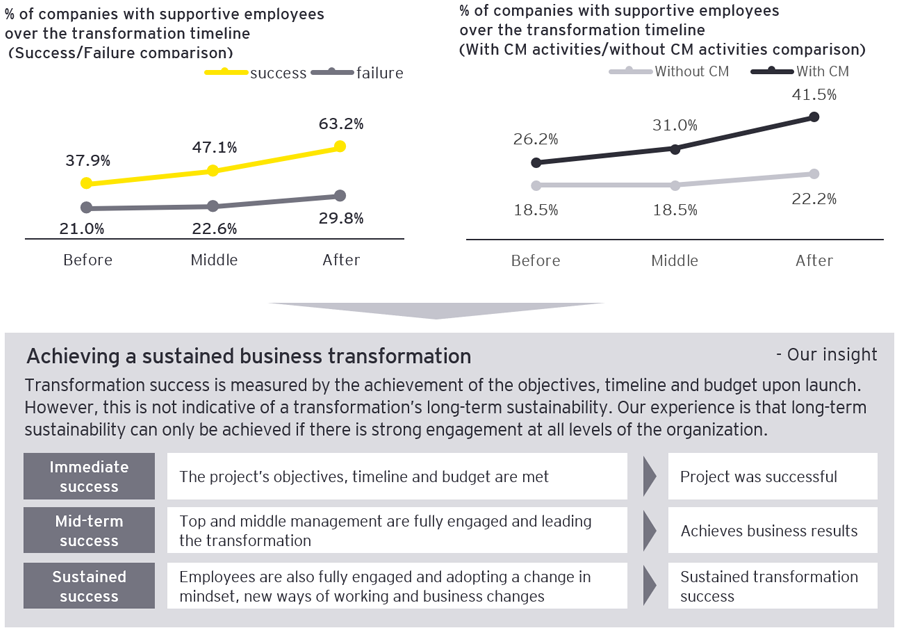
Who should be responsible for change management activities?
In identifying who is responsible for transformation change management activities, respondents were asked what group or division is currently responsible for change management activities and what group or division is expected to be responsible for future transformations. While no clear correlation was found between transformation success and the group or division responsible for change management activities, ensuring that all elements of change management are included in the project plan is key. Regardless of the group responsible, creating a structure with clear roles and responsibilities, and ensuring there is a dedicated focus on change management, increases the rate of success.
Actions needed for future transformations
If future transformations will be larger and more complex, as the results indicate, the employee reaction and impact needs to be anticipated and managed. Instead of addressing change the same way it was addressed in the past, the company should tailor change activities to recognize the personal change experience. For companies that do not have internal experience or capabilities to implement personalized change activities, independent change experts can partner to provide expertise and resources to focus on the right activities to accelerate transformation success.
How EY can help
EY has proven Change Management experience in Japan and around the world. This experience is enhanced through our acclaimed global change methodology and tools (see below), adapted for the Japan business and cultural needs. Our team of specialists can provide support throughout the entire change journey, including:
- Achieve alignment among executives, middle management and other stakeholders for a clear and consistent vision and goal for the change
- Accelerate engagement of employees with a personalized engagement strategy that results in active employee support
- Design and execute bespoke activities to improve the change readiness of employees, using data to measure, track and assess the impact and readiness for the change
- Plan and implement change management activities to accelerate adoption for a successful transformation
EY Change Experience
As change management is complexed, covers a wide range of activities and requires sensitivity and flexibility to change mindsets and behaviors, it is important to have a structured approach to build and execute a change plan. The acclaimed EY change management methodology, Change Experience, puts people at the center of change and treats change as a journey over the duration of the project. Change experience takes a purposeful approach, emphasizing why the change is necessary, provides an interactive and personalized experience so people understand how the change impacts their daily work, and insights measuring and using data to analyze and track change. Change management enables the organization to prepare, manage and embed the change, so the people and the business are ready, for a smooth and accelerated adoption.

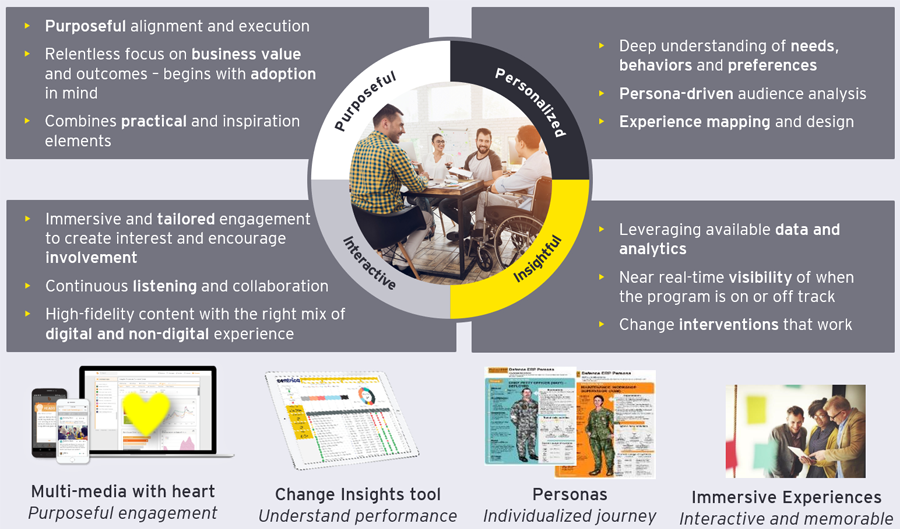
Summary
Businesses in Japan find themselves at a pivotal inflection point. Economic and social changes are motivating companies to accelerate their business transformations. But navigating change is not easy.
While many companies in Japan have executed transformations, most attempts failed to meet their objective. EY’s study found though that executing change management activities have a positive impact on success rate. Having engaged employees, for example, was found to be one of the key success factors and companies that focused on change management efforts were more likely to have supportive employees.
Many companies anticipate cross-functional transformations and significant changes in business strategy in the coming years. These types of transformations tend to be more complex and challenging, so having change management resources and capabilities to achieve a successful transformation is more important than ever before.


